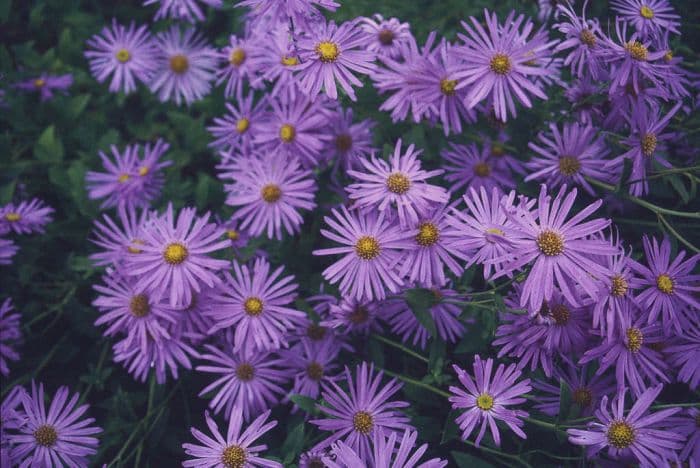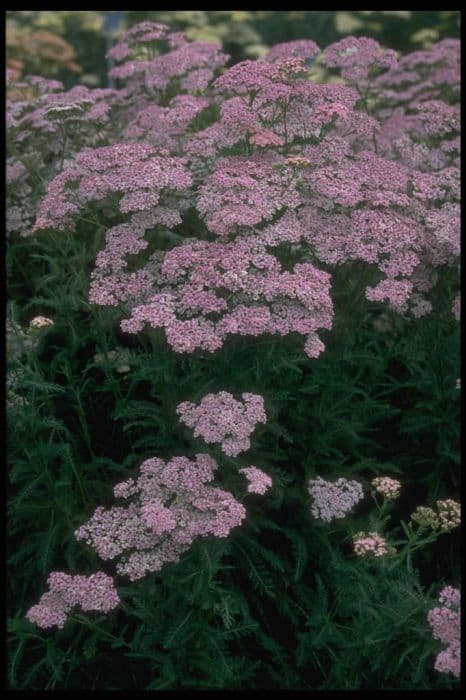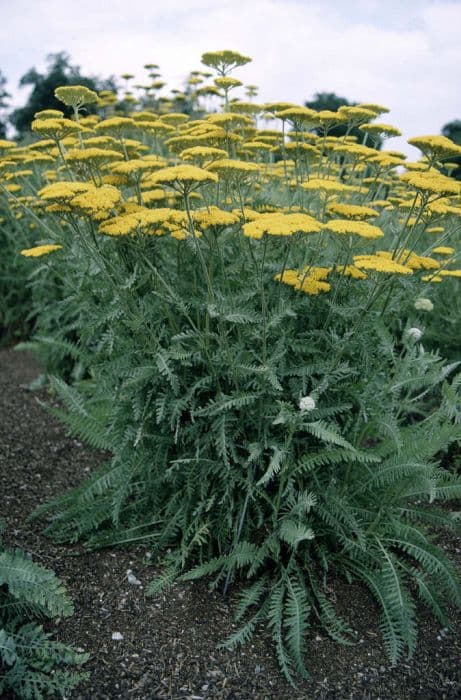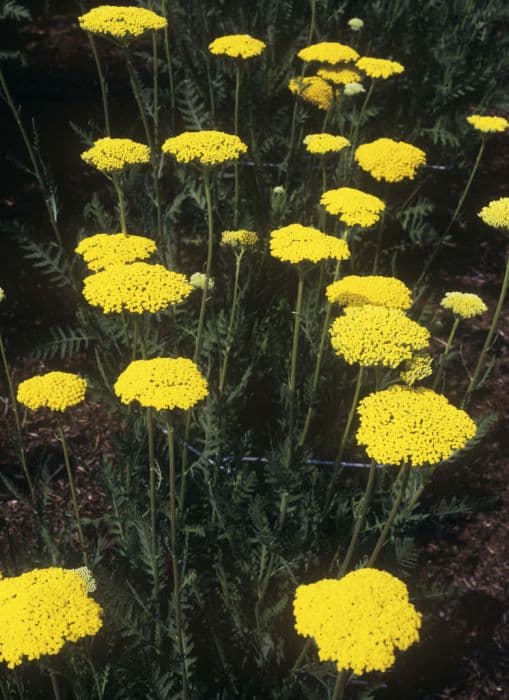Aster 'Mönch' Aster × frikartii 'Mönch'

ABOUT
'Mönch' is a bushy herbaceous perennial to 90cm, with dark foliage and yellow-centred, lavender-blue daisies 5cm across
About this plant
 Names
NamesFamily
Asteraceae
Synonyms
Frikart's Aster, Monch Aster
Common names
Aster × frikartii 'Mönch'.
 Characteristics
CharacteristicsLife cycle
Perennials
Foliage type
Deciduous
Color of leaves
Green
Flower color
Lavender
Height
2 feet (60 cm)
Spread
2 feet (60 cm)
Plant type
Herb
Hardiness zones
5
Native area
Europe
Benefits
 General Benefits
General Benefits- Attracts pollinators - The brightly colored blooms entice bees and butterflies, which are essential for pollination.
- Long blooming period - Frikart's Aster offers flowers from midsummer to early fall, providing color for an extended time.
- Drought tolerance - Once established, it is relatively drought-tolerant, making it suitable for xeriscaping or low-water gardens.
- Easy to care for - It is generally low-maintenance, not requiring much beyond the occasional watering and deadheading.
- Versatile in landscape - Can be used in borders, beds, and as cut flowers for arrangements due to its sturdy stems.
- Cold hardy - Can survive in cooler temperatures, which makes it a solid choice for many temperate gardens.
 Medical Properties
Medical PropertiesThis plant is not used for medical purposes.
 Air-purifying Qualities
Air-purifying QualitiesThis plant is not specifically known for air purifying qualities.
 Other Uses
Other Uses- Aster × frikartii 'Mönch' can be used to create a natural dye for fabrics, offering a range of colors from cool blues to purples depending on the mordant used.
- The flowers of the Aster 'Mönch' can be incorporated into pressed flower art, retaining their vibrant color for decorative purposes in framed artworks or bookmarks.
- The sturdy stems of Aster 'Mönch' can be used in the art of miniature fairy gardens to represent trees or larger plants due to their scale-like proportion.
- When dried, the petals of Aster 'Mönch' can be used to make organic confetti for celebrations that is both biodegradable and eco-friendly.
- Aster 'Mönch' can be useful in potpourri mixes, providing both a subtle fragrance and a splash of color when dried.
- The blooms can be used to garnish salads or desserts for an edible touch of elegance, as long as they have been grown without the use of pesticides.
- Aster 'Mönch' can act as a natural indicator of the changing seasons in educational settings, helping to teach children about phenology.
- The flowers can be used in the craft of candle making, carefully placed around the outside of pillar candles for a decorative touch.
- Petals from the Aster 'Mönch' can be included in homemade bath bombs or bath salts, adding color and a light aroma to bath products.
- Aster 'Mönch' can serve as a floral muse for artists and photographers, capturing the beauty of its blooms in various mediums and compositions.
Interesting Facts
 Feng Shui
Feng ShuiThe Frikart's Aster is not used in Feng Shui practice.
 Zodiac Sign Compitability
Zodiac Sign CompitabilityThe Frikart's Aster is not used in astrology practice.
 Plant Symbolism
Plant Symbolism- Patience: Asters are often associated with the virtue of patience, as they are late bloomers in the garden, bringing color and life when most other flowers have finished their display.
- Elegance: The delicate petals and graceful form of the Frikart's Aster can symbolize elegance and a refined beauty.
- Daintiness: With its slender stems and fine-textured foliage, the Frikart's Aster may represent daintiness and a soft, subtle beauty.
- Wisdom: Asters are sometimes symbolic of wisdom, as they are perceived to carry a mature and knowing presence in the plant world, blooming when all others have faded.
- Remembrance: Traditionally, asters are associated with the symbolism of remembrance, making them a fitting tribute in memory of a loved one or an event that should not be forgotten.
- Love of Variety: Asters come in a wide array of colors and types, which can represent a love of diversity and variety in life.
- Charm: The colorful and cheerful appearance of the Frikart's Aster can connote charm and an ability to captivate or delight others.
 Water
WaterFrikart's Aster should be watered regularly, especially during prolonged dry spells, to maintain an evenly moist soil environment. They typically need about 1 inch of water per week, either from rainfall or manual watering. It is best watered thoroughly to a depth of about 8 inches, rather than frequent shallow waterings, which encourages deep root growth. During the hottest part of the summer, you may need to water once or twice a week, while during cooler months or in well-established plants, the frequency may reduce to every other week.
 Light
LightFrikart's Aster thrives in full sunlight to partial shade conditions. The ideal location is one where the plant can receive at least 6 to 8 hours of direct sunlight daily. Providing full sun is particularly important for healthy blooms and stout, sturdy stems, though in very hot climates, some afternoon shade can help prevent wilting.
 Temperature
TemperatureFrikart's Aster prefers moderate temperatures and can survive minimum temperatures down to about 20°F, while maximum temperatures should not exceed 90°F for prolonged periods. The ideal growing temperature for this perennial is between 60°F and 75°F. However, they are quite cold-hardy and can survive winter freezing with proper mulching.
 Pruning
PruningPruning Frikart's Aster is essential for maintaining plant health and encouraging a bushier growth habit. Deadhead spent flowers regularly throughout the blooming season to encourage more blooms and prevent self-seeding. In late fall or early spring, cut back the entire plant to about 2 inches from the ground to promote vigorous new growth and improved air circulation.
 Cleaning
CleaningAs needed
 Soil
SoilFrikart's Aster thrives in well-draining soil with a mixture of loam, sand, and organic compost. Aim for a soil pH between 5.8 and 7.5, with a slightly acidic to neutral range being ideal. Ensure the soil mix is rich in nutrients and allows for proper moisture retention without becoming waterlogged.
 Repotting
RepottingFrikart's Aster does not require frequent repotting; it is typically repotted only when it has outgrown its current container or if the soil quality has deteriorated. This usually occurs every 2-3 years. When repotting, choose a slightly larger pot to accommodate root growth.
 Humidity & Misting
Humidity & MistingFrikart's Aster performs well in average outdoor humidity levels and does not require any special humidity adjustments. It is adaptable to the typical range found in most garden environments, which means no extra humidity control measures are necessary.
 Suitable locations
Suitable locationsIndoor
Provide bright light and well-draining soil for Frikart's Aster.
Outdoor
Plant in sunny spot with well-draining soil and space for growth.
Hardiness zone
5-9 USDA
 Life cycle
Life cycleFrikart's Aster 'Mönch' begins its life cycle when seeds are sown, usually after the danger of frost has passed in spring. Germination occurs over several days to a few weeks, depending on temperature and moisture conditions. Upon sprouting, the seedlings develop into juvenile plants, producing a basal rosette of leaves and a root system. Throughout the growing season, the plant grows vegetatively, developing a bushy habit with branches and an increasing number of leaves. Flowering typically occurs in late summer to early fall, when numerous lavender-blue, daisy-like flowers with yellow centers bloom. After flowering, seeds form and mature, which are then dispersed, starting the life cycle anew if conditions are favorable, or the plant may enter a period of dormancy during the winter.
 Propogation
PropogationPropogation time
Late summer
Propogation: The Frikart's Aster (Aster × frikartii 'Mönch') is most commonly propagated by division, which is ideally carried out in the spring as new growth appears. To propagate by division, carefully dig up the plant and use a sharp spade or knife to divide the clump into several smaller sections, each with a portion of the root system and several shoots. It's crucial to replant the divisions promptly at the same depth they were growing before and water them thoroughly to encourage establishment. Divisions should be spaced about 18 inches (approximately 45.72 centimeters) apart to allow ample room for growth. This method promotes a robust new plant much faster than seed and keeps the desirable characteristics of the parent plant.









